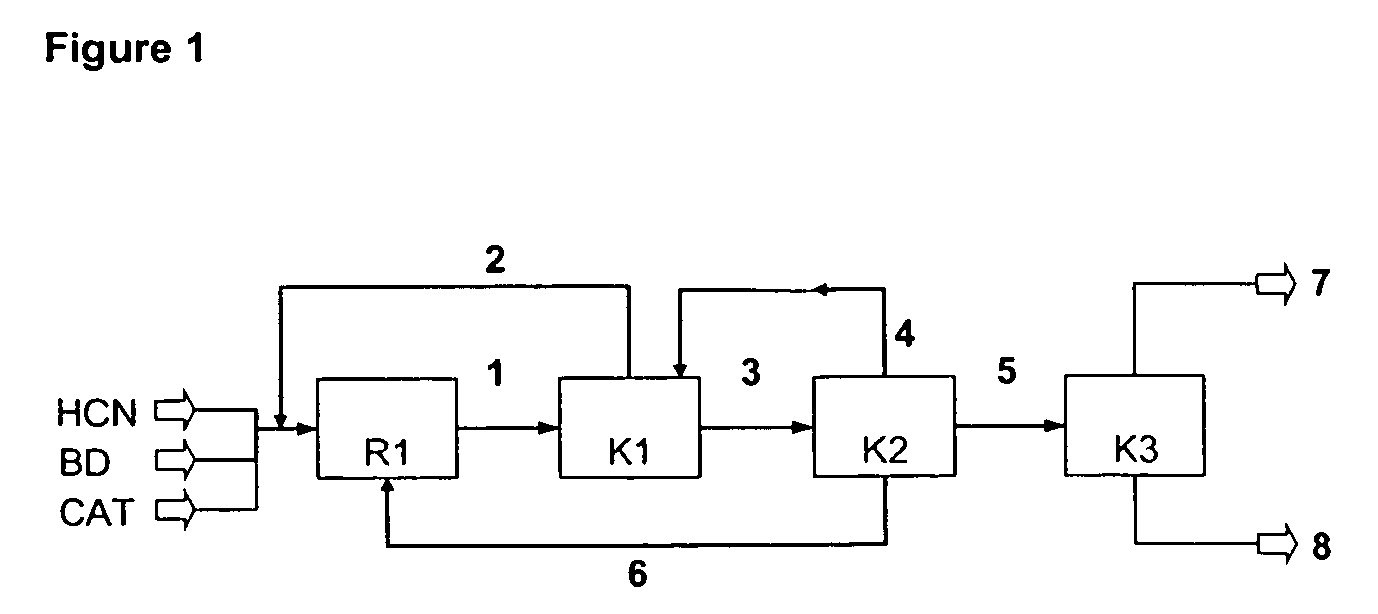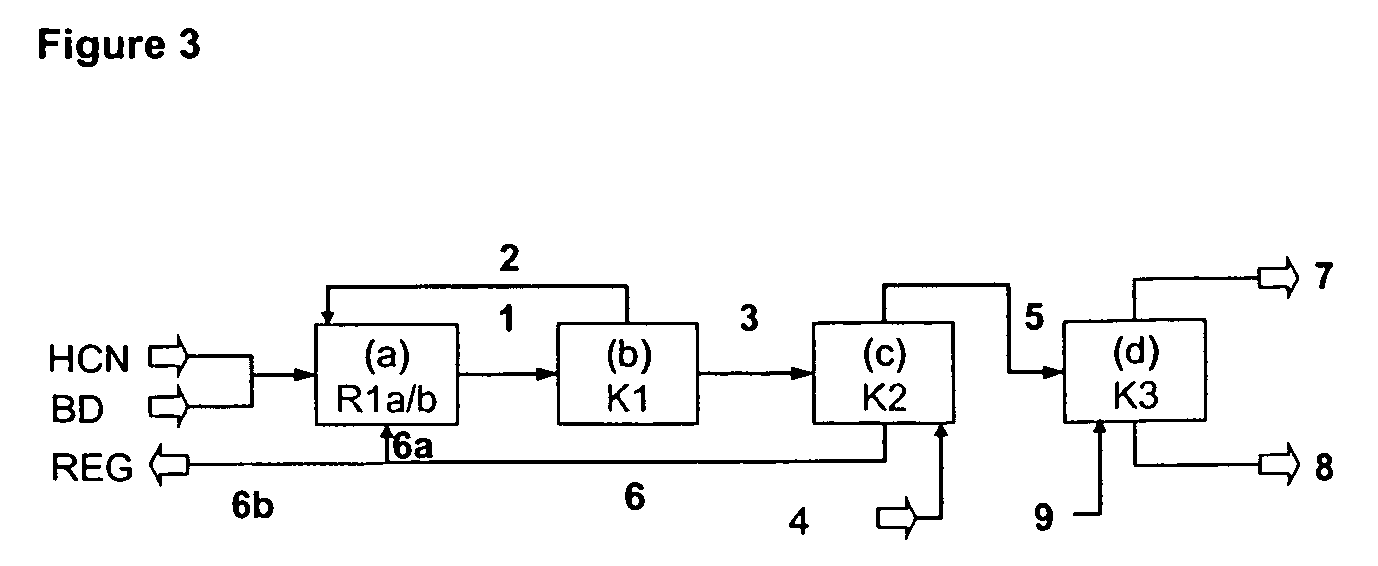Method for producing 3-pentenenitrile
a technology of pentenesium pentacoxide and 3-pentenesium pentacoxide, which is applied in the preparation of carboxylic acid nitrile, hydrogen cyanide addition, organic chemistry, etc., can solve the problem of thermal labileness of homogeneously dissolved hydrocyanation catalysts, and achieve the effect of increasing the process yield
- Summary
- Abstract
- Description
- Claims
- Application Information
AI Technical Summary
Benefits of technology
Problems solved by technology
Method used
Image
Examples
example 1
[0160]Example 1 is illustrated with reference to FIG. 2.
[0161]In Example 1, a catalyst system based on nickel(0) complexes with a mixture of ligands is used for the hydrocyanation of 1,3-butadiene. The ligand mixture for the hydrocyanation contains approx 60 mol % of tri(m / p-tolyl) phosphite and 40 mol % of the chelate phosphonite 1:
[0162]
[0163]In a process step (a), the following streams are conducted into a loop reactor R1 of capacity 25 l which is equipped with a nozzle, impulse exchange tube, external pumped circulation and a heat exchanger disposed in the pumped circulation system to remove the energy of the reaction, and is heated at 357 K:[0164](1) 10 kg / h of liquid, unstabilized hydrogen cyanide freed of water by distillation;[0165](2) 22 kg / h of commercial tert-butylpyrocatechol-stabilized 1,3-butadiene containing 0.25% by weight of cis-2-butene, the 1,3-butadiene having been treated by contact with alumina in order to remove water and the stabilizer;[0166](3) 8 kg / h of rec...
example 2
[0182]Example 2 is illustrated with reference to FIG. 3.
[0183]In Example 2, a catalyst system based on nickel(0) complexes with chelate phosphite 2 as the ligand is used for the hydrocyanation of 1,3-butadiene:
[0184]
[0185]In a process step (a), the following streams are conducted into a system composed of two reactors R1a and R1b, each of capacity 12 l, and each of which is equipped with a nozzle, impulse exchange tube, external pumped circulation and a heat exchanger disposed in the pumped circulation system for removing the energy of reaction, and heated at 363 K:[0186](1) 6 kg / h of liquid, unstabilized hydrogen cyanide freed of water by distillation to R1a; [0187](2) 6 kg / h of liquid, unstabilized hydrogen cyanide freed of water by distillation to R1b; [0188](3) 25 kg / h of commercial 1,3-butadiene to R1a, containing 0.25% by weight of cis-2-butene, the 1,3-butadiene having been treated by contact with alumina in order to remove water and the stabilizer;[0189](4) 2 kg / h of recycle...
example 3
[0204]Example 3 is illustrated with reference to FIG. 4.
[0205]In Example 3, a catalyst system based on nickel(0) complexes with a mixture of ligands is used for the hydrocyanation of 1,3-butadiene. The ligand mixture for the hydrocyanation contains approx. 80 mol % of tri(m / p-tolyl) phosphite and 20 mol % of the chelate phosphite 2.
[0206]In a process step (a), the following streams are conducted into a system composed of three continuous stirred tanks R1a, R1b and R1c connected in series, each of capacity 10 l, which are heated to 373 K:[0207](1) 5.2 kg / h of liquid, unstabilized hydrogen cyanide freed of water by distillation to R1a; [0208](2) 4.0 kg / h of liquid, unstabilized hydrogen cyanide freed of water by distillation to R1b; [0209](3) 23 kg / h of 1,3-butadiene as stream 2 from the condenser of the evaporator B1 in process step (b), containing 92% by weight of 1,3-butadiene, 2% by weight of trans-3-pentenenitrile, 4% by weight of 2-methyl-3-butenenitrile and approx. 2% by weight...
PUM
| Property | Measurement | Unit |
|---|---|---|
| temperatures | aaaaa | aaaaa |
| temperatures | aaaaa | aaaaa |
| temperatures | aaaaa | aaaaa |
Abstract
Description
Claims
Application Information
 Login to View More
Login to View More - R&D
- Intellectual Property
- Life Sciences
- Materials
- Tech Scout
- Unparalleled Data Quality
- Higher Quality Content
- 60% Fewer Hallucinations
Browse by: Latest US Patents, China's latest patents, Technical Efficacy Thesaurus, Application Domain, Technology Topic, Popular Technical Reports.
© 2025 PatSnap. All rights reserved.Legal|Privacy policy|Modern Slavery Act Transparency Statement|Sitemap|About US| Contact US: help@patsnap.com



